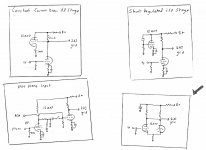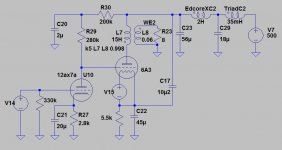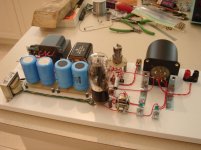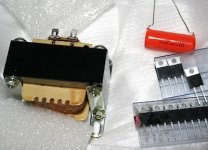Member
Joined 2009
Paid Member
I have a stock of 60+ 2A3 tubes; RCA, Sylvania, Philco, Zenith, Ken-Rad, Tung-Sol, some original single-plate, typical twin with single plate and some true dual triode configurations (collected over 4+ decades... I'm pretty old). After exhaustive testing in multiple circuit topologies, I'm convinced that 3.5K is more optimum overall but you'll get the best overall performance by pushing them to ~16W of plate dissipation. I'm using older Tek, HP and Fluke test gear for all measurements.
I am liking the idea of trying the 3.7k impedance load.
You have a lot of 2A3's there. I have none! - do you find that you have a preference between them ? I have been thinking about the JJ-2A3-40, the prospect of buying NOS on ebay at high prices and not much guarantee is a little worrying.
Also curious - do you have an opinion on the use of a.c. heating vs d.c. heating of the 2A3 providing one uses a tube with filament structure conducive to hum cancellation (such as the JJ-23-40 rather than the mono-plates) ?
I am liking the idea of trying the 3.7k impedance load.
You have a lot of 2A3's there. I have none! - do you find that you have a preference between them ? I have been thinking about the JJ-2A3-40, the prospect of buying NOS on ebay at high prices and not much guarantee is a little worrying.
Also curious - do you have an opinion on the use of a.c. heating vs d.c. heating of the 2A3 providing one uses a tube with filament structure conducive to hum cancellation (such as the JJ-23-40 rather than the mono-plates) ?
Well, there are basically three different styles of NOS 2A3 tubes:
1- original singleplate
2- early dual triodes in parallel (true dual triode sections, plates, grids, filaments)
3- later dual triodes which use a single anode structure covering two filament/grid assemblies.
I don't have any of the new manufactured stuff, like the JJ, so can't comment on them in any way.
On the AC vs DC debate, I prefer AC when possible, but it gets down to tube quality and circuit design to achieve an acceptable signal-to-noise ratio. My personal criteria is 80dB minimum referenced to 1-watt. I have dozens of matched pairs of 45 triodes which can meet this criteria, some are around 90dB and with AC filaments. Many others are between 70- and 75dB and some duds up around 60dB. Getting 2A3 tubes this quiet (the 80dB and better mark) is difficult, but not impossible. But if you're not looking to go thru a lot of samples and can't get the s/n down to your own limits, then you'll have to go DC.
Overall, I prefer the Sylvania dual-section (single anode) early types... using coil springs for filament tension (4 total on the top micas), followed by their later version using the "fishing rod" tension wire. Ken-Rad made some very nice smoked glass 2A3s which are true dual triodes in parallel. My least loved are the RCA gray-plate dual-section (single anode) and the RCA blackplate versions seem better like by most.
The early single plate 2A3 is more expensive to implement (DC filament requirement due to it's center-tapped design), is not as robust and can not be pushed past 15-watts like the later dual-section types. However, as it's a true single triode, is can really shine, but they are rare, have a very high cost, hence not a great return on the investment, unless you already have them from years ago. I have four of the RCA Cunningham SP with engraved bases, keepers for a future project.
Regards, KM
Just FWIW, the SET amps I've heard that I liked best used a pentode to drive the output triode. In theory, they balance out each other's distortion resulting in a better (less audible) set of harmonics.
Once you get used to the 12AX7 input valve, I'd be curious to know what you think of a pentode in that position. Just a suggestion.
Once you get used to the 12AX7 input valve, I'd be curious to know what you think of a pentode in that position. Just a suggestion.
The 12Ax7 is a very poor choice to drive a 2A3. The 2A3 takes a lot of drive.
The EF86 as pentode is much better.
the 12Ax7 is ok if you like sound with no dynamics and restricted hi frequencies.
Phil
The EF86 as pentode is much better.
the 12Ax7 is ok if you like sound with no dynamics and restricted hi frequencies.
Phil
Multi, have you tried a 12AX7 driving a 2A3? I use that set up right now (direct coupled) and I find no lack of dynamics nor loss of high frequency. I have built dozens of amps both SE and PP and dozens of different driver schemes, this one works very well. People who listen to it are always impressed and several of those include musicians. This weekend I played some orchestral stuff for a woman who used play violin in a symphony, she commented on the quality of detail in the highs and remarked how it seems so similar to her experience sitting in a symphony orchestra.
12AX7 types
Well, I'll admit it's not my first choice for an input/driver but it certainly has simplicity on it's side. It also has limitations when matched against the input capacitance of the 2A3 and the higher voltage swings needed to maintain a wide bandwidth at higher power levels.
I built a small SET many years ago using a 6SF5 direct-coupled to a 45 with MQ OPTs. Circuit is somewhat similar to the fi45 with a higher plate supply voltage to the 6SF5. It's a decent performer and overall a good sounding amplifier, which spends countless hours driving a pair of Fostex F120a drivers when company visits.
On measurements, it's -2dB @ 20KHz @ 1watt (reference 1KHz). At 25KHz it's -3dB. THD measures around 1.8% @ 1KHz @ 1-watt. The same iron with a better input/driver topology is pretty flat to 30KHz with the same OPTs and THD is below 0.5% under the same test conditions.
Note that the 2A3 has higher input capacitance than the 45 and will be a bit more of a challenge to drive. So yes, you can have an acceptable performing amplifier, but can also get better performance with a better design.
Regards, KM
Well, I'll admit it's not my first choice for an input/driver but it certainly has simplicity on it's side. It also has limitations when matched against the input capacitance of the 2A3 and the higher voltage swings needed to maintain a wide bandwidth at higher power levels.
I built a small SET many years ago using a 6SF5 direct-coupled to a 45 with MQ OPTs. Circuit is somewhat similar to the fi45 with a higher plate supply voltage to the 6SF5. It's a decent performer and overall a good sounding amplifier, which spends countless hours driving a pair of Fostex F120a drivers when company visits.
On measurements, it's -2dB @ 20KHz @ 1watt (reference 1KHz). At 25KHz it's -3dB. THD measures around 1.8% @ 1KHz @ 1-watt. The same iron with a better input/driver topology is pretty flat to 30KHz with the same OPTs and THD is below 0.5% under the same test conditions.
Note that the 2A3 has higher input capacitance than the 45 and will be a bit more of a challenge to drive. So yes, you can have an acceptable performing amplifier, but can also get better performance with a better design.
Regards, KM
Member
Joined 2009
Paid Member
Multi, have you tried a 12AX7 driving a 2A3? I use that set up right now (direct coupled) and I find no lack of dynamics nor loss of high frequency. I have built dozens of amps both SE and PP and dozens of different driver schemes, this one works very well. People who listen to it are always impressed and several of those include musicians. This weekend I played some orchestral stuff for a woman who used play violin in a symphony, she commented on the quality of detail in the highs and remarked how it seems so similar to her experience sitting in a symphony orchestra.
good to know !
Well, I'll admit it's not my first choice for an input/driver but it certainly has simplicity on it's side. It also has limitations when matched against the input capacitance of the 2A3 and the higher voltage swings needed to maintain a wide bandwidth at higher power levels.
When I was designing SS amps with global feedback it was always important to have lots of drive and a very high gain-bandwidth product to ensure that the global feedback was able to maintain good distortion reduction with minimal feedback way up into the high treble. But in a no-global feedback valve amp like this I don't carry the same concern. I'm only wanting to ensure I get good treble, that it doesn't roll off prematurely. And my calculations say the 12AX7 is good enough. But remember also that there are plenty of others who have heard amps like this and found them just fine, or even fantastic.
I found some comments on the web from somebody who attended the RMAF '07 and heard the Serious Stereo 2A3, which uses a 7B4 as the driver - not so different from half a 12AX7. "I did'nt hear any problems with the treble region with Dennis's rig either. Emmylou Harris is a good test for how the treble integrates with the mid, and Dennis played one of her recordings at my request. ", Paul Eizik . KM, Your experience sounds to have been equally positive about the lack of issue with the sound of a 'wimpy driver'.
I also remember my own experience with a friends experiments using a 6C45Pi high-transconductance 'russian wonder tube' driving a 6C4C and finding it a bit dry to my liking. Well I was reading an old copy of Sound Practices today, 1993, an article about a SE 211 amplifier by Dennis Boyle. I notice a comment "We conducted empirical trials of dozens of low output impedance tube/topology combinations [..]. Initially we had high hopes for high transconductance triodes but listening results were typically poor - even though the "specs" looked very good."
Talking of Sound Practices, another article that caught my attention was J. C. Morrison's 'siren song' pre-amp. I found it interesting because of the use of a cathode coupled amplifier at the input which allowed the designer to avoid the use of a cathode bypass capacitor. Such a capacitor is something that is currently part of the design proposed in this thread and being at the cathode of a high-mu input tube it must necessarily have a strong influence on the sonics of the amplifier. A quote from J.C. M's article "A differential amplifier can be imagined as a single-ended stage with its cathode decoupled by the low internal resistance of the cathode of a second tube, rather than by the low impedance of a capacitor."
So if I reach back to post 48 and update my options to include a differential i/p - which also has the benefit of reducing the current variations through the B+ supply.
Attachments
Last edited:
Perhaps you're taking a bit too much liberty with my reply. Note that the amps mentioned above are used only for background music and they're fine for that (and yea, the F120a is overkill for b/g music). If I'm going to sit down and spin some vinyl, I use a different pair of 45 amps that are far better in every detail (and a completely different design). Again, it depends on what is (personally) acceptable and for what purpose. I still like the little 45 amps mentioned earlier, but my application is likely to be different from yours.
Regards, KM
Regards, KM
Member
Joined 2009
Paid Member
Perhaps you're taking a bit too much liberty with my reply. Note that the amps mentioned above are used only for background music and they're fine for that (and yea, the F120a is overkill for b/g music). If I'm going to sit down and spin some vinyl, I use a different pair of 45 amps that are far better in every detail (and a completely different design). Again, it depends on what is (personally) acceptable and for what purpose. I still like the little 45 amps mentioned earlier, but my application is likely to be different from yours.
Regards, KM
Hi KM, my apologies if I took some liberties.... anyhow, I would be very interested to learn about your 45 amp - there can never be too many projects !
Well I decided to fiddle around with LTspice on a rainy day to see how the Western Electric version of power supply noise cancellation would work. I like it because it's relatively simple although less convenient to adjust than the L-W version.
The attached shows my results. First image is the circuit schematic I used. I'm not 100% confident that the tube models are perfect but the idea was to get a sense of things rather than a perfectly accurate simulation. You can see the WE noise cancellation cap from the output tube cathode to the B+ (I think it's C17 on this drawing).
The 2nd image shows the PSRR, where the lower line (purple) is the result for the WE version. Removing the WE 'ultra-path cap' C17 gets me the upper line (green). It's fairly clear that the WE approach provides an improvement in PSRR of a fairly substantial amount - depending on how well the value of the cap is adjusted to 'null out' the noise.
The 3rd image shows the Frequency Response of the amplifier. I wouldn't read too much into the high freq. roll off as it appears to be dependent on the OPT coupling coefficient more than anything else. The interesting thing is the low freq. 'bump' from the non-WE version, which as has been pointed out in an earlier post, arrises from a L.F. resonance in the power supply (low DCR = low damping) and which is not present with ultra-path WE capacitor.
Attachments
Last edited:
+1 to the AX7 being a less-than-optimal choice. Your amp will end up being very sensitive (which you will perceive as "noisy"), and there are other tubes with similar gain that won't have the limitations (6GK5, 12AT7 with CCS, 6922).
If you plan to use some global feedback, the 12AX7 will be more suitable.
In the end, get a piece of wood and some cheap ceramic sockets and give it a shot.
If you plan to use some global feedback, the 12AX7 will be more suitable.
In the end, get a piece of wood and some cheap ceramic sockets and give it a shot.
Member
Joined 2009
Paid Member
get a piece of wood and some cheap ceramic sockets and give it a shot.
Good idea auidiowize - there's a good chance this is what I'll do.
As for input tube, yes, I may well try out some alternatives (see first post of this thread).
Bigun, NP. I've done a couple clean sheet designs for the 45 and 2A3/6B4G in the past 6 years or so. One I made public.... uses a 12AT7 as an input/driver dc coupled, 1st as gain stage and 2nd as cathode follower, RC coupled to the output tube. This can easily drive more than 125 volts p-p and wide bandwidth. Sensitivity with a 45 is around 775mv input for 1-watt output. With good iron, the design is within 1dB at 35KHz and low distortion. With good tubes, s/n is better than 80dB (referenced 1-watt) with AC filaments.
The other (earlier) design uses a 5814A in a different topology and all Hashimoto iron... parts cost alone are very expensive so I never put the design public. It is within 1dB from 25Hz to 50KHz at 1-watt. Typical THD measures below 0.4% at 1-watt (1KHz) and s/n is better than 85dB (referenced 1-watt) and has pretty high gain... ~250mv for 1-watt. These are still my favorite amps, haven't even completed building the 2A3 version 5 years later.
RE Audiowize: agreed, breadboard it... I always start on a breadboard after the initial design and testing starts. I use a basic white MDF shelf board commonly available at places like Home Depot in the US, add rubber feet on the bottom and build it up.
Regards, KM
The other (earlier) design uses a 5814A in a different topology and all Hashimoto iron... parts cost alone are very expensive so I never put the design public. It is within 1dB from 25Hz to 50KHz at 1-watt. Typical THD measures below 0.4% at 1-watt (1KHz) and s/n is better than 85dB (referenced 1-watt) and has pretty high gain... ~250mv for 1-watt. These are still my favorite amps, haven't even completed building the 2A3 version 5 years later.
RE Audiowize: agreed, breadboard it... I always start on a breadboard after the initial design and testing starts. I use a basic white MDF shelf board commonly available at places like Home Depot in the US, add rubber feet on the bottom and build it up.
Regards, KM
Attachments
Member
Joined 2009
Paid Member
KM,
Man, that's so darn neat I'd just put a cage over it and call it 'done' !
p.s. did you get much trouble with the storm down in Florida recently ?
Man, that's so darn neat I'd just put a cage over it and call it 'done' !
p.s. did you get much trouble with the storm down in Florida recently ?
Nah, breadboard, not final.... here's a link to some pics of the first mini-chassis build:
The best amateur photography lives on Webshots
No issues from the storm... just some wind / rain. NJ will have more fun with Sandy this time. Thanks.
Regards, KM
The best amateur photography lives on Webshots
No issues from the storm... just some wind / rain. NJ will have more fun with Sandy this time. Thanks.
Regards, KM
Member
Joined 2009
Paid Member
So you don't mind using a CF to driver the grid of the output tube ? - I ask because the CF has a 'mixed reputation' - perhaps mostly amongst the uninformed...
Hardly, the input/driver is very clean, wide bandwidth and swings a high output voltage. It has a gain of ~50 volts/volt measured from the input to the grid of the 45. It will drive a 10KHz square at 100 volts pk-pk at the 45 grid with no signal degradation. It's also flat to 50KHz (sinewave) at the 45 grid. In short, what's to not like? It's simple, cost effective and it actually works very well.
Regards, KM
Regards, KM
Member
Joined 2009
Paid Member
Hi Kevin,
In one of your amps you have a CF driving the grid of the output tube directly, with no bias of the cathode - the cathode is connected to the grid and nothing else. So the only current that would flow through the driving tube would be equal to that flowing into the grid. I like how this would auto-bias the driver tube, but wouldn't this be highly non-linear ?
Well I got a few more parts today - the Triad choke (35mH), orange drop that will be in the snubber across the secondary of the power trafo, some Cree SiC diodes and a few other bits.
In one of your amps you have a CF driving the grid of the output tube directly, with no bias of the cathode - the cathode is connected to the grid and nothing else. So the only current that would flow through the driving tube would be equal to that flowing into the grid. I like how this would auto-bias the driver tube, but wouldn't this be highly non-linear ?
Well I got a few more parts today - the Triad choke (35mH), orange drop that will be in the snubber across the secondary of the power trafo, some Cree SiC diodes and a few other bits.
Attachments
Hi Kevin,
In one of your amps you have a CF driving the grid of the output tube directly, with no bias of the cathode - the cathode is connected to the grid and nothing else. So the only current that would flow through the driving tube would be equal to that flowing into the grid. I like how this would auto-bias the driver tube, but wouldn't this be highly non-linear ?
Well... snip
Ah, you've navigated a bit and found the 3C24 Class A2 SET amp ;-). The grid on the 3C24 needs to be biased positively to get any current flow at the low plate voltage used (normal plate voltage on a 3C24 can be 2000 volts). The later version used a 5651 reference tube and a voltage divider to set a regulated grid drive to the 6FQ7, which in turns drives the 3C24 grid and you can set your A2 idle current. The input amp feeds the driver via RC coupling so the audio signal rides on the grid voltage. It's a low-cost way to get reasonable performance without buying IT iron, but the topology has inherent limitations. This was a short project done over a few days time using an existing breadboard setup. Overall, performance was quite good with ~4 watts of power... kinda like a 2A3 but with a lot more heat and complexity, hence I never constructed a final pair.
Regards, KM
I built a similar amp, with a little tweaking I managed to get some clean, quiet power out of it.
An externally hosted image should be here but it was not working when we last tested it.
Member
Joined 2009
Paid Member
- Home
- Amplifiers
- Tubes / Valves
- A nice little valve amplifier





